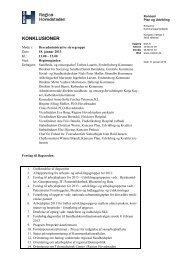Territorial Review Copenhagen - Region Hovedstaden
Territorial Review Copenhagen - Region Hovedstaden
Territorial Review Copenhagen - Region Hovedstaden
Create successful ePaper yourself
Turn your PDF publications into a flip-book with our unique Google optimized e-Paper software.
52<br />
Several cities of comparable size can claim to be considerably more<br />
global. Metropolitan areas need not necessarily be large to have a strong<br />
global presence, as is illustrated in the case of Brussels, Amsterdam, Zurich,<br />
Geneva and Dusseldorf. Not only do they have a more global presence in<br />
general, they also have more sectors in which they are more global: all of<br />
them rank in the top 50 in all four sectors that were studied; <strong>Copenhagen</strong><br />
only in two. Other northwest European cities, in addition to Amsterdam, that<br />
appear more global than <strong>Copenhagen</strong>, are Stockholm and Hamburg, which<br />
both appear in the top 50 of three sectors. What is more, these competitor<br />
cities not only have more sectors in which they are global, they also are<br />
more global in the sectors in which <strong>Copenhagen</strong> is most global: Amsterdam<br />
and Hamburg score higher in global accounting; and Stockholm and<br />
Amsterdam score higher on global advertisement. This is of relevance for<br />
the attraction of foreign investment and highly skilled labour, as will be<br />
shown below. Business activities of global services firm also provide<br />
important links with other global cities. When a client contacts a<br />
professional services firm in <strong>Copenhagen</strong>, there is an 87% probability that<br />
the firm has an office in London, as well as New York, Toronto, Sydney,<br />
Milan, Stockholm, Madrid and Paris. The highest probability that a firm in a<br />
foreign city would also have an office in <strong>Copenhagen</strong> is in Stockholm<br />
(61%), followed by Hamburg, Atlanta, Dusseldorf, Minneapolis,<br />
Amsterdam and Barcelona. 15 These economic relations between global<br />
services firms suggest that there are important economic links between<br />
<strong>Copenhagen</strong> and these cities.<br />
There are indications that business in <strong>Copenhagen</strong> has become less<br />
internationally oriented over the last decades, by comparison with other<br />
metropolitan areas in the OECD. When looking at links between global<br />
advanced producer firms, some observers conclude that <strong>Copenhagen</strong> lost<br />
global economic standing over the period from 2000-04 (Taylor and Aranya,<br />
2007). This relative loss in its international position is particularly clear in<br />
certain economic sectors: global competition has had a severe impact on<br />
Denmark‘s finance industry. International finance has undergone extreme<br />
specialisation: the functions that generally generate the highest value added<br />
have become increasingly concentrated in the past few decades in a top tier<br />
of cities, leaving the other functions to lower-tier cities. Intensified<br />
competition and industrial development among middle- to lower-tier cities<br />
resulted in greater spatial differentiation, marginalising some cities. In 1980,<br />
only three vertical tiers of cities can be identified in the world of<br />
international finance. This has increased to seven tiers by 1998.<br />
<strong>Copenhagen</strong>, which formed part of the third tier in 1980, had fallen back to<br />
the sixth tier by 1998. Amsterdam, Luxembourg, Milan and Paris, which<br />
were in the third tier in 1980, managed to remain in this tier (Poon, 2003).

















